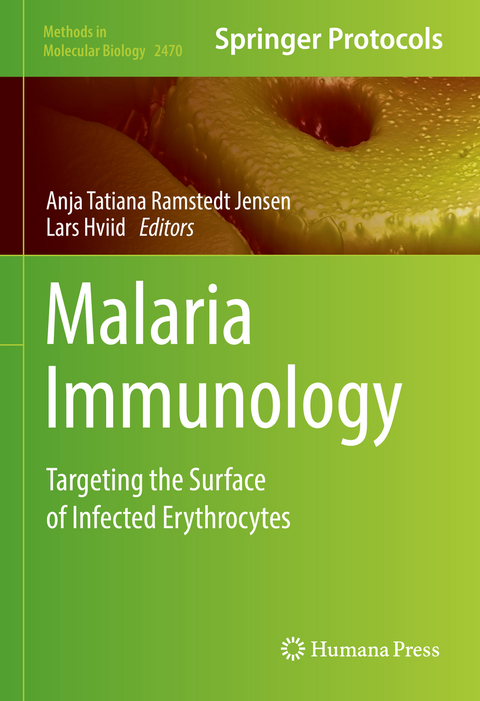
Malaria Immunology
Springer-Verlag New York Inc.
978-1-0716-2188-2 (ISBN)
Authoritative and cutting-edge, Malaria Immunology: Targeting the Surface of Infected Erythrocytes aims to be a useful and practical guide to researches to help further their study in this field.
Chapter Analysis of var gene transcription pattern using DBLα-tags [Chapter 14] is available open access under a Creative Commons Attribution 4.0 International License via link.springer.com.
Identification and enumeration of Plasmodium falciparum parasites by light microscopy.- Collection and cryopreservation of Plasmodium falciparum clinical isolates in the field.- Preservation of parasite RNA in the field.- Preservation and extraction of malaria parasite DNA from dried blood spots.- Establishing and maintaining in vitro cultures of asexual blood stages of Plasmodium falciparum.- Genotyping of Plasmodium falciparum isolates to assess clone composition in parasite cultures.- Immunomagnetic selection of Plasmodium falciparum-infected erythrocytes expressing particular PfEMP1 variants.- Single-cell sorting of Plasmodium falciparum-infected erythrocytes expressing particular PfEMP1 variants.- Selecting Plasmodium falciparum infected erythrocytes for adhesion to cell lines.- Synchronisation of Plasmodium falciparum and P. knowlesi in vitro cultures using a highly specific protein kinase inhibitor.- Generation of Plasmodium falciparum gametocytes in vitro with specific considerations for field isolates.- Imaging of extracellular vesicles derived from Plasmodium falciparum-infected red blood cells using atomic force microscopy.- Analysis of var gene transcript patterns by quantitative real-time PCR.- Analysis of var gene transcription pattern using DBLα-tags.- RNAseq of infected erythrocyte surface antigen-encoding genes.- Resetting var gene transcription in Plasmodium falciparum.- CRISPR/Cas9 editing of the Plasmodium falciparum genome.- CRISPR-Cas9 editing of the Plasmodium falciparum genome - Special applications.- Extraction and immunoprecipitation of VAR2CSA, the PfEMP1 associated with placental malaria.- Expression of single-domain soluble and disulfide-folded PfEMP1 antigens in the Escherichia coli SHuffle expression system.- Expression of large full-length PfEMP1 proteins in HEK293 cells.- Receptor affinity-based purification of PfEMP1 proteins.- Analysis of antibody reactivity to malaria antigens by microsphere-based multiplex immunoassay.- High-throughput BioPlex assay for the study of functionally active Plasmodium falciparum antigens that are expressed on the surface of infected erythrocytes.- Protein microarrays as a tool to analyze antibody responses to variant surface antigens expressed on the surface of Plasmodium falciparum-infected erythrocytes.- Protocol for differential biopanning of Plasmodium falciparum phage display cDNA library to identify parasite targets of protective antibodies.- Affinity purification of PfEMP1-specific antibodies from human blood.- Production of anti-PfEMP1 polyclonal antisera in rats and mice.- Production of PfEMP1-specific mouse monoclonal antibodie.- Production of PfEMP1-specific human monoclonal antibodies from naturally immune individuals.- Visualization of infected red blood cell surface antigens by fluorescence microscop.- Analysis by flow cytometry of α2‑macroglobulin and non-immune IgM-binding to Plasmodium falciparum-infected erythrocytes.- An improved method for assessing antigen presentation on the surface of Plasmodium falciparum-infected erythrocytes by immuno-electron microscopy.- Assessing antigen presentation on the surface of Plasmodium falciparum-infected erythrocytes by photoactivated localization microscopy (PALM).- Surface plasmon resonance analysis of PfEMP1 interaction with receptors.- Analysis of antibody neutralization of PfEMP1 binding by competition ELISA.- Measuring rosetting inhibition in Plasmodium falciparum parasites using a flow cytometry-based assay.- Bridging and clumping: investigating platelet interactions with Plasmodium falciparum-infected red blood cells and endothelial cells in cerebral malaria.- Assay of static adhesion of Plasmodium falciparum-infected erythrocytes to cells, including inhibition of the adhesion.- Static adhesion of Plasmodium falciparum-infected erythrocytes to purified and recombinant receptors.- Selecting Plasmodium falciparum-infected erythrocytes for adhesion to recombinant receptors under flow conditions.- Chip-based assay of adhesion of Plasmodium falciparum-infected erythrocytes to cells under flow.- Binding of Plasmodium falciparum-infected red blood cells to engineered 3D microvessels.- 3D organoid assay of the impact of Plasmodium falciparum-infected erythrocyte adhesion on the blood-brain barrier.- Receptor-functionalized lipid membranes as biomimetic surfaces for adhesion of Plasmodium falciparum-infected erythrocytes.- Antibody-dependent THP-1 cell-mediated phagocytosis of Plasmodium falciparum-infected erythrocytes.- Assaying interactions between neutrophils and Plasmodium falciparum-infected red blood cells.- Natural killer cell antibody dependent cellular cytotoxicity (ADCC) activity against Plasmodium falciparum-infected red blood cells.- Assessing PfGARP-mediated apoptosis of blood-stage Plasmodium falciparum parasites.- Enzyme-linked immunosorbent assay for activation of the classical complement pathway by Plasmodium falciparum-infected erythrocyte surface antigen-specific antibodies.- Flow cytometry assay of Plasmodium falciparum-specific B-cell proportions.- Assessment of Plasmodium falciparum antigen-specific B cells.- Whole blood dendritic cell cytokine production assay.- Measuring the impact of malaria on the living human retina.- Ocular pathology of cerebral malaria.- Investigating interactions between endothelial cells and parasitised red blood cells in skin and subcutaneous tissue.
| Erscheinungsdatum | 29.07.2022 |
|---|---|
| Reihe/Serie | Methods in Molecular Biology ; 2470 |
| Zusatzinfo | 124 Illustrations, color; 20 Illustrations, black and white; XIX, 796 p. 144 illus., 124 illus. in color. |
| Verlagsort | New York, NY |
| Sprache | englisch |
| Maße | 178 x 254 mm |
| Themenwelt | Medizin / Pharmazie ► Medizinische Fachgebiete ► Mikrobiologie / Infektologie / Reisemedizin |
| Studium ► Querschnittsbereiche ► Infektiologie / Immunologie | |
| Naturwissenschaften ► Biologie ► Mikrobiologie / Immunologie | |
| Schlagworte | immunology • Malarial parasites • Microscopy • model systems • Transcriptomics |
| ISBN-10 | 1-0716-2188-2 / 1071621882 |
| ISBN-13 | 978-1-0716-2188-2 / 9781071621882 |
| Zustand | Neuware |
| Haben Sie eine Frage zum Produkt? |
aus dem Bereich


